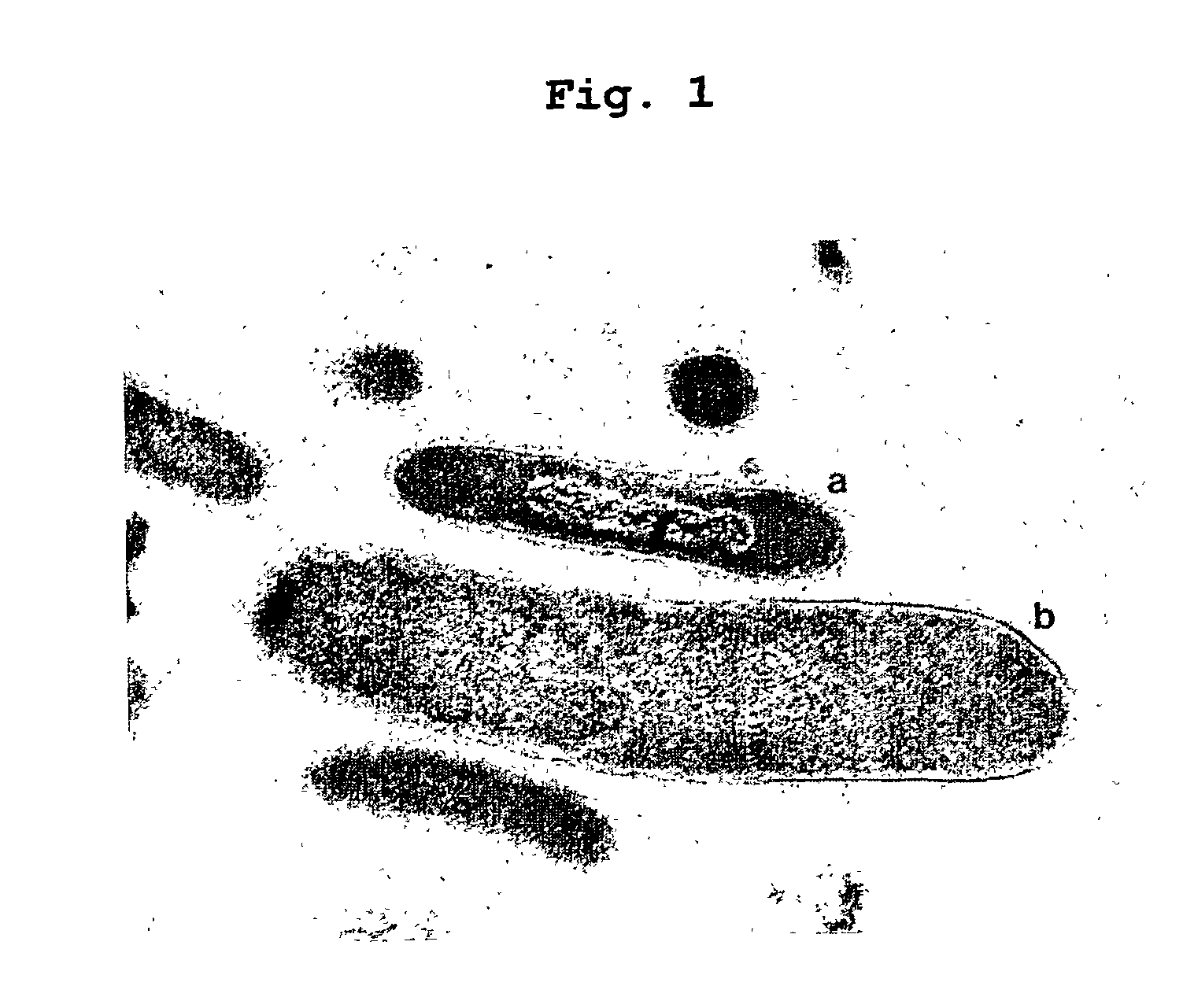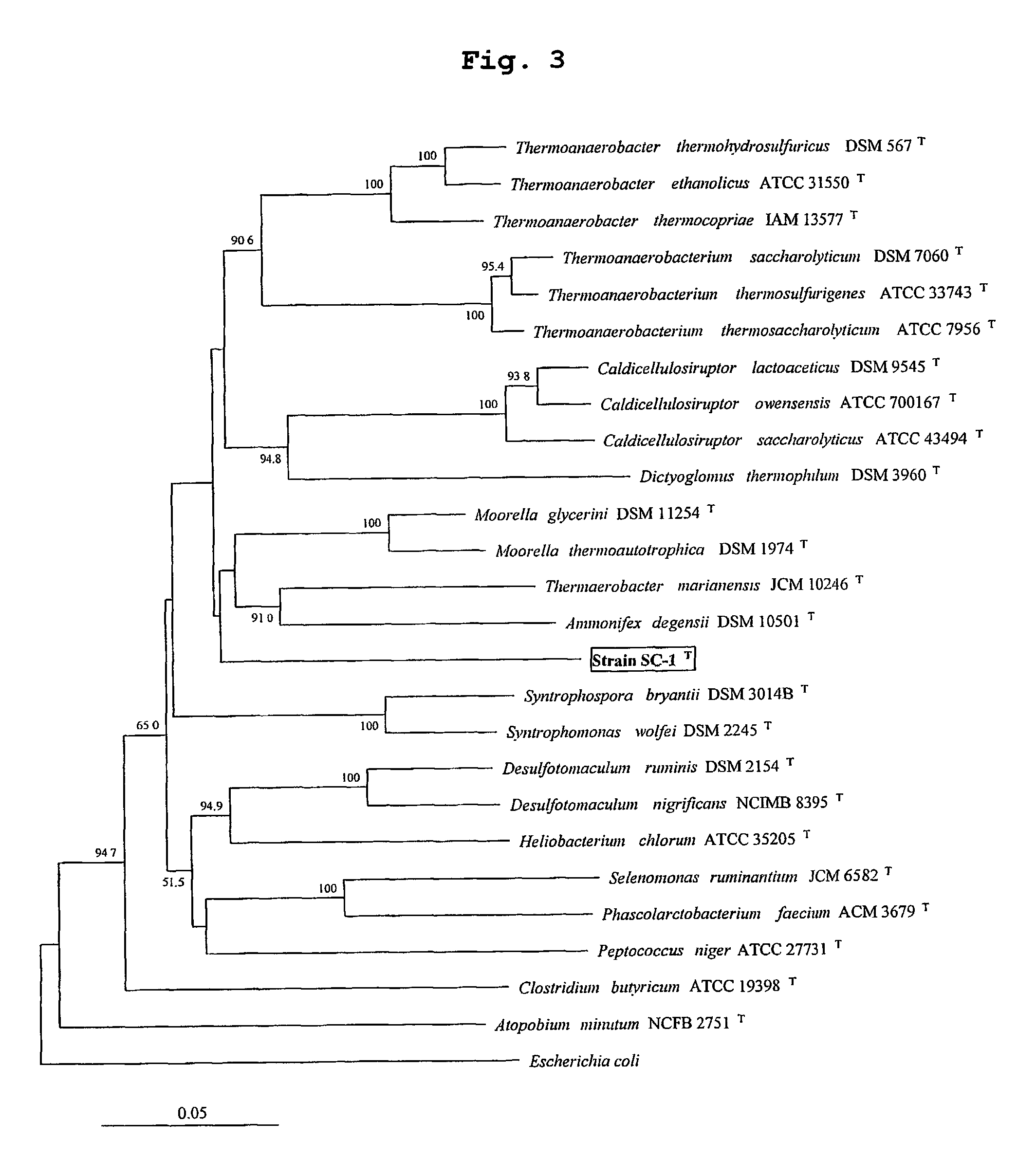Obligately symbiotic thermophile symbiobacterium toebii SC-1 producing thermostable L-tyrosine phenol-lyase and L-tryptophan indole-lyase and a method for screening its relative bacteria
a technology of obligate symbiotic bacteria and thermophile, which is applied in the direction of lyases, bacteria-based processes, instruments, etc., can solve the problems of low thermostableness of mesophile, easy denature, and reduced productivity and production rate of enzymatic biotransformation process, and achieve high thermostable enzyme activity
- Summary
- Abstract
- Description
- Claims
- Application Information
AI Technical Summary
Benefits of technology
Problems solved by technology
Method used
Image
Examples
example 1
Identification of Symbiobacterium toebii SC-1
Search for Microorganisms Showing a Thermostable L-tyrosine phenol-lyase Activity
[0066]To initiate enrichment cultures for isolating L-tyrosine phenol-lyase-producing microorganisms, these inventors used a basal medium (BM). The BM contained 5 g of polypeptone, 1 g of yeast extract, 6 g of K2HPO4, 2 g of KH2PO4, 0.5 g of MgSO27.H2O, and 0.5 g of L-tyrosine per liter of deionized water.
[0067]Specifically, enrichment cultures were initiated by inoculating BM with 1% compost samples. The samples were collected from compost yards in Kongjoo, Korea. The cultures were performed in 500 ml Erlenmeyer flasks with 200 ml of BM at 60° C. in a gyratory shaker. After two weeks of incubation, phenol, as a product of tyrosine phenol-lyase, was detected in the culture broth by reacting it with 4-aminoantipyridine reagent. Two milliliters of the culture showing phenol-positive reaction were transferred to 200 ml of fresh BM three times. The phenol was fu...
example 2
Measurement of Thermostable L-tyrosine phenol-lyase and L-tryptophan indole-lyase Activities
[0079]In order to measure enzyme activities of the thermostable L-tyrosine phenol-lyase and L-tryptophan indole-lyase produced by the identified novel symbiotic thermophile Symbiobacterium toebii SC-1 in this invention, these inventors prepared a crude cell extract. Particulary, Symbiobacterium toebii SC-1 was inoculated into liquid MBM, incubated under anoxic conditions with nitrate. The culture medium was then centrifuged to separate the cells. After that, a crude cell extract was obtained by sonicating the above cell pellets. Thermostable L-tyrosine phenol-lyase and L-tryptophan indole-lyase activity produced by Symbiobacterium toebii SC-1 were measured using this crude cell extract.
Thermostable L-tyrosine phenol-lyase Activity
[0080]To measure the enzyme activity of the thermostable L-tyrosine phenol-lyase produced by Symbiobacterium toebii SC-1, these inventors prepared an reaction mixtu...
example 3
Growth Measurement of Symbiobacterium toebii SC-1 by Determining Nitrite Produced from Nitrate Respiration
[0087]Since Symbiobacterium sp. strains were bacteria showing a very low growth yield, it was impossible to represent their growth by measuring their absorbances at OD600 using spectrophotometer but also by counting number of micro-colonies.
[0088]We used nitrate respiration under anaerobic conditions to determine the growth of Symbiobacterium toebii SC-1. It was confirmed that Symbiobacterium toebii SC-1 performed nitrate respiration under anaerobic growth conditions. Besides oxygen, Symbiobacterium toebii SC-1 used nitrate as an electron acceptor and reduced nitrate into nitrite. It also produced ATP using redox potential generated from nitrate respiration and used ATP for its growth.
[0089]As described above, because the growth of Symbiobacterium toebii SC-1 using nitrate reduction coincides with accumulation of nitrite, its growth could be determined by measuring the amount of...
PUM
| Property | Measurement | Unit |
|---|---|---|
| pH | aaaaa | aaaaa |
| temperature | aaaaa | aaaaa |
| diameter | aaaaa | aaaaa |
Abstract
Description
Claims
Application Information
 Login to View More
Login to View More - R&D
- Intellectual Property
- Life Sciences
- Materials
- Tech Scout
- Unparalleled Data Quality
- Higher Quality Content
- 60% Fewer Hallucinations
Browse by: Latest US Patents, China's latest patents, Technical Efficacy Thesaurus, Application Domain, Technology Topic, Popular Technical Reports.
© 2025 PatSnap. All rights reserved.Legal|Privacy policy|Modern Slavery Act Transparency Statement|Sitemap|About US| Contact US: help@patsnap.com



